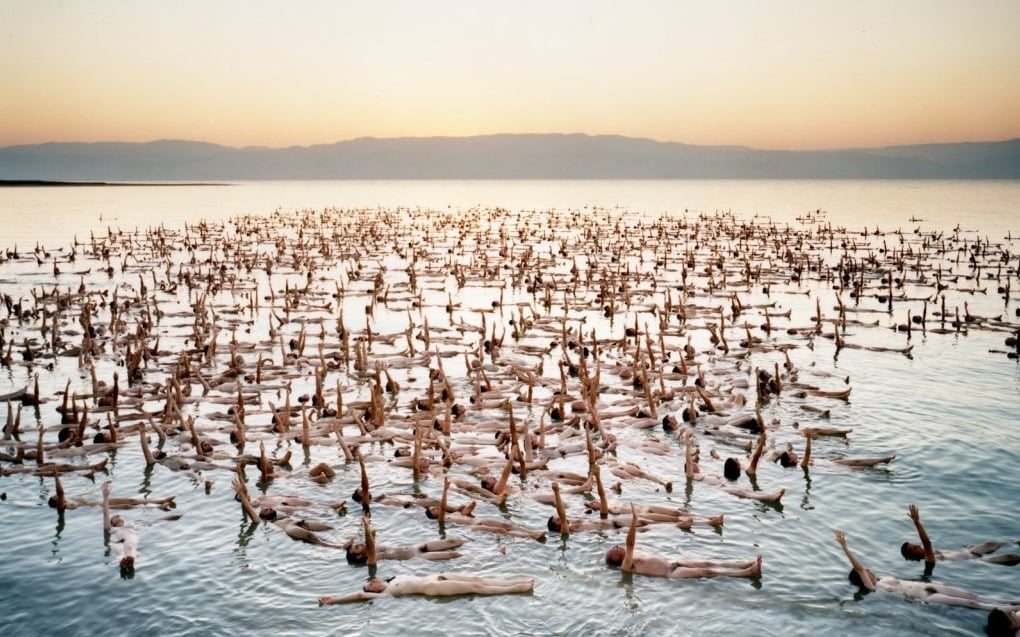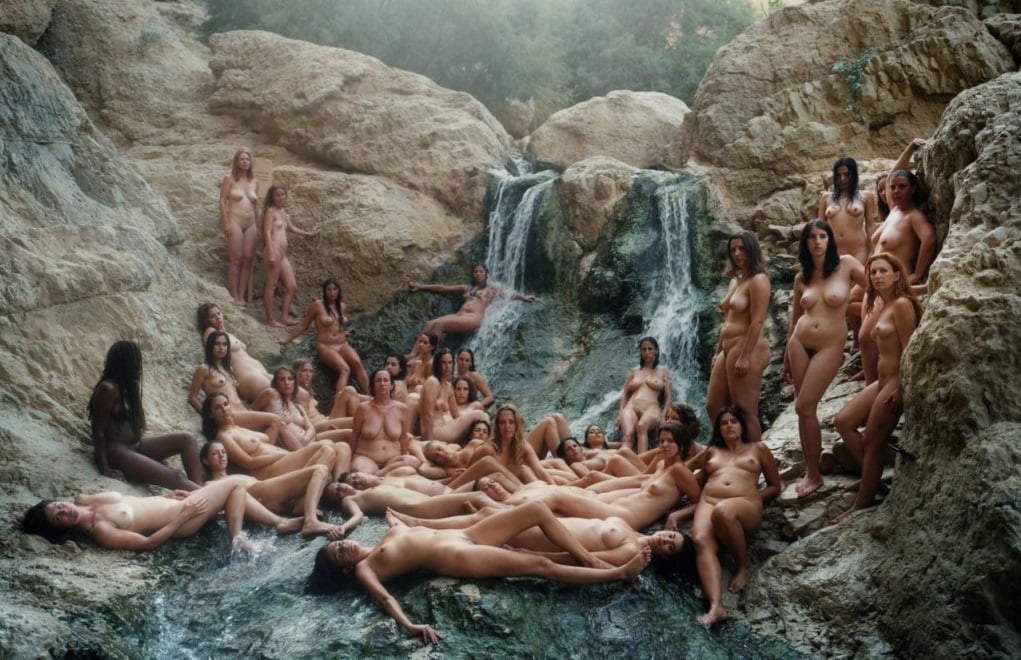
I met the artist Spencer Tunick recently at his home in Greenwich Village. He showed me the many nudes he has been photographing over the past ten years. He combines conceptual elements with urban settings. His photographs are a document of a live performance. Most of his work has not been seen, except in magazines. Now with much of his nude series near completion, we will be seeing the work in a setting the way it was meant to be shown. Spencer's work is usually done in the morning. He finds an interesting setting or juxtaposition, and takes a picture of a nude person or group of nude people. The work is done quickly with early morning risers looking on with approval or disapproval. Spencer has been arrested a few times for creating indecency, but his work is not pornography, but visual constructs. He has photographed many famous New York people, and hundreds of anonymous people who have collaborated in this strange world of Spencer Tunick. His work is fun, exciting, and yet sometimes political.
I always think of your work like I do think of Joseph Beuys' or Yves Klein's work. The photography is a documentation of the real art, which was the public performance that happened already, with all these nude people, or one nude person in an urban situation.
Spencer Tunick: There is a solid piece that comes from it, the event that is a performance. I turn everyday people, for one morning of their lives, into performance artists. Then, they return to their lives, for the rest of the day. So it's quasi-documentary, quasi-performance, quasi-conceptual. It's in-between everything, so that's why I don't really consider myself a straight photographer.
Do you use a lot of heavy equipment or expensive cameras or plates?
ST: I'd love to have the money and a truck to do all that. You need a truck to haul around an 8 x 10 camera. It would be a very slow process, and I have to get this done before the police show up. Some of my shoots take place in the street, so safety is my number one concern. To set up a big camera would be insane, so I just use a medium format, with one camera and one lens, since 1990. It's not about technology. Sometimes I'm so nervous, that I don't hold the camera strong enough or I drop out of focus. With my "Naked States Tour" I incorporated the idea of a traveling artist. I set out to document a situation or an experience. I was influenced by Robert Frank's book The Americans, where he went around to 48 states and photograph people there. I liked Edward Ruscha's series of gas stations.
How many people have you photographed nude over the years?
ST: Probably over two thousand. To do my art, you have to be able to work with the masses. It's hard. The only connection you have with the masses is if you're in government or in music. Those have been great organizers. I thought to myself, the only way to create large shoots on the road was to go to festivals and ask them whether or not I could create my work within the context of those festivals. I went to this Phish concert in Maine. I went to Sturges. I couldn't find anyone. I went to Burning Man in the Nevada Desert and got 160 people to pose. I could have had over 500 people but I didn't wait. The internet was our main form of organizing the shoots. I posted my journal on my site and contacted many people over the internet. I sent snapshots to a person who kept the website up, and people who were interested could follow our journey on the road. I want to launch a book on the web. I think that is an interesting way of showing work.

Spencer Tunick, Dead Sea 4 (2011).
Did you have any problems with the police? Did they stop you or take away your cameras?
ST: In Indiana we were stopped by the Indiana State Police. They said that they were going to confiscate my van, my photo equipment. Both the models and myself were nervous. There was three police cars. One of the officers saw us in the middle of a shoot. I didn't know how I was going to get out of it this time. In New York, I can call my lawyers. William Kunstler helped me on my first case. CNN had done a piece on one of my arrests before. Just off the top of my head I asked them "If they watched CNN and do they remember a photographer getting arrested trying to photograph a male nude on top of the crystal ball at Rockerfeller Center?" Four out of the six officers had seen it. That softened them up a little. They started to listen to me. I told them that "I am an artist. I'm not a pornographer. I'm out of state. I'm here to do this one picture." I showed them my pictures and they started to get into it, and everything started to change around. That was my one dealing with the police on this tour.
What do you think of some of these photographers who have been getting a lot of attention recently like Charles Gatewood, Eric Kroll, and Richard Kern?
ST: Gatewood mostly documents stuff. I like Eric Kroll's early work. His black and white photographs of his wife. They weren't as aggressive. There was no bondage. As far as Richard goes: I like his work and he likes my work. We trade prints. But I don't trade for his bondage prints. I like his softer stuff and he likes anything I do. Again I'm not a big fan of photography. I like pockets of an artist's work. There's not so many artists who are working with nudes these days where you like everything that they do. I do like Sally Mann. I hope that she continues to photograph her children as they grow older. I like things that are conceptual. I don't like pure documentation although I like Larry Clark's work. It's voyeuristic yet real. I also like Chris Burden and Nancy Rubins.
Is music or films an influence?
ST: On this tour we listened to Pavement, Radiohead, and Dylan. When we got to California we listened to Crosby, Stills & Nash. The Spinanes and Cibo Matto. AS far as films, I'm into Ray Harryhausen. Special effects. Japanese creature films. I'm very fantasy oriented.
What was this picture about?
ST: This one is about chemical warfare. It's on my poster. I was interested in violence, not domestic violence, but violence in the United States. To create an explosion beforehand, it soothes me and prepares me. On my shoots I do two set-ups. One is more abstract, and then I do one that is just chaos. Those shoots are like therapy because I can then deal with my fear of terrorism and loss of life.
Your prints are very large. Many people miss out on that when they see them only in magazines
ST: The great thing about having a show, is that you can exhibit it in the way that the artist meant you to see it. When you see it in a magazine, you don't realize what the scale is of the photographs. The best people to work with are people who have a sense of art as it hangs in a gallery or museum. They know that they're not going to see their picture in a pornographic context. A lot of people on the Naked States tour, had never seen art before. They had only seen Playboy Magazine. Sometimes I had to discuss my work for an hour, and talk about figurative nudes.
Are you are very tactile person?
ST: Uh. (pause) I like to work with my hands. Sometimes I have breakfast with the models afterwards. If they want to give me a massage on my shoulders, that's fine. I'm very professional. I meet a lot of people and am very open-minded.
www.spencertunick.com

Spencer Tunick, Dead Sea 15 (2011).


1 comment:
Post a Comment